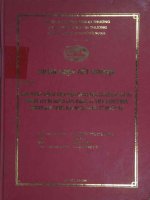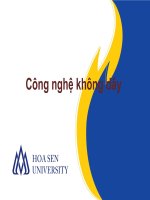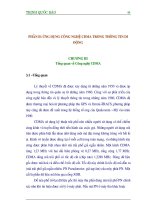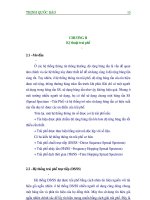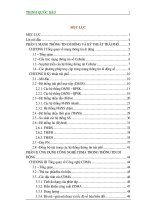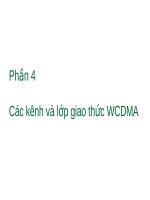Bài giảng Thông tin di động: Phân cấp vùng phục vụ trong mạng GSM - TS. Đỗ Trọng Tuấn
Bạn đang xem bản rút gọn của tài liệu. Xem và tải ngay bản đầy đủ của tài liệu tại đây (2.02 MB, 37 trang )
2/17/2014
Trường Đại học Bách Khoa Hà Nội
Viện Điện tử Viễn thông
Thông tin di động
Mobile Communications
TS. Đỗ Trọng Tuấn
Bộ môn Kỹ thuật thông tin
Hà Nội, 04-2011
1
2/17/2014
Phân cấp vùng phục vụ
trong mạng GSM
2
2/17/2014
Phân cấp vùng phục vụ GSM
Location Information-GSM Service Area Hierarchy
3
2/17/2014
Phân cấp vùng phục vụ GSM
Location Information-GSM Service Area Hierarchy
GSM Service Area
Service area = the area
in which a subscriber
an access the network.
4
2/17/2014
Vùng phục vụ PLMN
5
2/17/2014
Vùng định vị LAI và vùng phục vụ MSC/VLR
Vùng định vị LA là vùng gồm một số cell do nhà
quy hoạch ấn định tại đó MS có thể di chuyển tự
do mà không cần cập nhật lại vị trí.
6
2/17/2014
Số nhận dạng vùng định vị LAI
3 digits
2 digits
Mobile country
Code (MCC)
Mobile
Network Code
(MNC)
2 Bytes
Location Area
Code (LAC)
Số LAI: Location Area Identity => Số nhận dạng vùng định vị
3 digits
Mobile country
Code (MCC)
2 digits
2 Bytes
2 Bytes
Mobile Network Location Area Global Cell
Code (MNC)
Code (LAC) Identity (GCI)
Số nhận dạng ơ tồn cầu GCI:
GCI = MCC + MNC + LAC + GCI = LAI + GCI
7
2/17/2014
Phân cấp vùng phục vụ GSM
Location Information-GSM Service Area Hierarchy
8
2/17/2014
Phân cấp vùng phục vụ GSM
Location Information-GSM Service Area Hierarchy
9
2/17/2014
Phân cấp vùng phục vụ GSM
Location Information-GSM Service Area Hierarchy
Số nhận dạng vùng định vị LAI được lưu giữ
ở đâu ?
10
2/17/2014
Phân cấp vùng phục vụ GSM
Location Information-GSM Service Area Hierarchy
11
2/17/2014
Ví dụ
12
2/17/2014
Kênh tại giao diện vô tuyến Um
13
2/17/2014
Giao diện vô tuyến Um
14
2/17/2014
FDMA
Frequency
Channel
Time
15
2/17/2014
Kênh tần số trong hệ thống GSM và DCS
16
2/17/2014
TDMA
Time Slot
Frequency
Channel
0
1
2
3
4
5
6
7
Time
17
2/17/2014
Khái niệm
Kênh vật lý là phương tiện truyền tải thơng tin.
Tại Um:
• Kết hợp sử dụng 2 phương thức đa truy nhập
FDMA và TDMA.
• Kênh vật lý CH = TSi є ARFCNj
Kênh logic là thông tin mang trên kênh vật lý
18
2/17/2014
Channels : differentiating between
Physical and Logical channels
Physical channels : The combination of an ARFCN
and a time slot defines a physical channel.
Logical channels : These are channels specified by
GSM which are mapped on physical channels.
19
2/17/2014
Kênh vật lý và kênh logic
20
2/17/2014
Chế độ làm việc song công - Duplex
FDD: Frequency Division Duplex
TDD: Time Division Duplex
960 MHz
124
959.8MHz
123
GSM900 utilizesTS:
two
of 25 MHz. 890Timebands
slot
……
.
DOWNLINK
Downlink
(TDMA
frame)
= 8 the
TS
915 MHz band is
used for
uplink
while
……
is used for downlink.
0935-960
1 2 MHz
3 4 5 6 7
2
200KHz
935.2 Mhz
1
935 MHz
FDD
915 MHz
914.8 MHz
45 MHz
124
123
……
.
UPLINK
200KHz
The frequency bands are divided into 200
KHz wide channels called ARFCNs (Absolute
Radio Frequency
Channel
Numbers)
Data burst = 156.25
bit periods
= 576.9s i.e.
there are 124 ARFCNs are used.
TDD ARFCN supports 8 users with each user
Each
transmitting / receiving on a particular time
0 1 2 3 4 5 6 7
Delay
slot
(TS).
……
Uplink (TDMA frame)
2
890.2 MHz
1
890 MHz
Duplex methods
Therefore 1 TDMA frame = 156.25 x 8 = 1250 bits
and has a duration of 576.92s x 8 = 4.615 ms
21
2/17/2014
Time Slot & Burst
P (dB)
148
bits = 542,8 µs
+4 dB
- 6 dB
± 1 dB
34 dBm
- 30 dB
- 70 dB
156,25 bits = 577 µs
t (µs)
Mức cơng suất phát của MS biến thiên theo thời gian
Time Slot: khe thời gian
Busrt: Cụm thông tin
22
2/17/2014
Phân cấp cấu trúc khung - Frame hierarchy
1 hyperframe = 2048 superframes = 2715648 TDMA frames
0
1
2
……
3
2044
2045
2046
2047
3 h 28 min 53.76 s
1 superframe = 51 (26frame) multiframes
OR
26 (51 frame) multiframes
6.12 s
0
1
2
0
……….
3
47
48
……….
1
49
24
50
25
26 * 51 = 1326 TDMA Frames
1 trafic multiframe = 26TDMA frames
T0
T1
…..
T11
S
T12
…..
1 control multiframe = 51TDMA frames
T24
I
T0
T1
T2
T3
….
…..
…..
T48
T49
T50
235.4 ms
120 ms
0
1
...
slot
577 µs
burst
6
7
4.615 ms
TDMA Frame
23
2/17/2014
Cấu trúc cụm bình thường NB – Normal Burst
Power p(t)
useful part
f2
f1
0 1 2 ... 7 0 1 ...
0 1 2 ... 7 0 1 ...
t
156.25 Bits in 576.923 s
(3.6923 s/Bit)
Stealing Flag
3 Tail Bits
26 Training Bits
2 x 57 Encrypted Bits
3 Tail Bits
8.25 Bits Guard Period
24
2/17/2014
Normal Burst
4.615ms
0
1
2
3
4
5
6
7
TB: tail bit
TB
3
Data
57
S
F
1
Training
26
S
F
1
Data
57
TB
3
148 bits
156.25 bits = 0.577ms
• To carry information on the TCH and all control channels except
for RACH, SCH and FCCH
• The two sets of encrypted 57 bits are data or speech
…….
25
2/17/2014
Normal Burst
•The stealing flag (SF) indicates whether the burst was
stolen for signaling or not.
•The 3 tail bits are (0,0,0) and is used as the start/stop
pattern.
• The GP (guard period of 8.25 is used to prevent
overlapping of frames
•The 26 training bits is a known bit sequence to get an
estimate of how the channel is affected by interference
26
2/17/2014
Synchronization Burst
MTS
4.615ms
0
TB
3
1
2
Encrypted
Bits 39
3
4
5
Extended training bits
64
6
Encrypted
Bits 39
BTS
7
TB
3
148 bits
156.25 bits = 0.577ms
• This burst is used for time synchronization of the mobile
• The long training sequence is a synchronization sequence
• The encrypted 78 bits carry the information of the TDMA frame
number and the BSIC (Base Tranceiver Station Identity Code)
27
2/17/2014
Frequency Correction Burst
MTS
4.615ms
0
1
TB
3
2
3
4
Fixed all zeros
142
5
6
BTS
7
TB
3
148 bits
156.25 bits = 0.577ms
• This burst is used for frequency synchronization of the mobile
• The sequence of fixed zeros is equivalent to an unmodulated
carrier.
28
2/17/2014
Access Burst
4.615ms
0
1
TB
8
2
Syn.
Sequence
41
3
4
Encrypted
message
36
5
TB
3
6
7
Additional
guard time
60
148 bits
156.25 bits = 0.577ms
• The random access burst has a longer guard period since the mobile
does not know the timing advance when it randomly accesses the
system
29
2/17/2014
Cấu trúc cụm tại giao diện vô tuyến
NB
FB
SB
DB
AB
30
2/17/2014
Kênh logic
31
2/17/2014
Kênh lưu lượng - TCH
32
2/17/2014
Kênh lưu lượng TCH
TCH/FS : for speech digitized at raw data
rate of 13 kbps (FS: Full Speech): Bm
TCH/HR: for speech digitized at raw data
rate of 6.5 kbps (HS: Half Speech):Lm
TCH/9.6 -> data transfer rate at 9.6 kbps
TCH/4.8, TCH/2.4 . . .
33
2/17/2014
Kênh điều khiển - CCH
34
2/17/2014
Control Channels
Functions:
• To help the MS find the control channels.
• To provide information about
- voice and control channel repetition cycle.
- parameters in the cell.
- surrounding cells.
- paging.
• To allow random access attempts by the MS.
35
2/17/2014
Nhóm kênh điều khiển quảng bá BCH
In general mapped to BCCH ARFCN on TS0.
Broadcast control channels consist of:
-
Kênh điều khiển quản bá: BCCH - Broadcast Control
Channel .
-
Kênh hiệu chỉnh tần số FCCH – Frequency Correction
Channel.
-
Kênh đồng bộ SCH - Synchronization Channel
36
2/17/2014
Broadcast Control Channel (BCCH)
Serves as a Beacon for the Cell
Country Code (CC) and the Network Code (NC)
Location Area Identity (LAI) and
List of neighboring cells which should be
Cell identity
monitored by MS
List of frequencies used in the cell
37
2/17/2014
Frequency Correction Channel-FCCH
Allows each user unit to synchronize its
internal frequency standard with BTS
Repeated each 10 frame in control
multiframe
38
2/17/2014
Synchronization Channel (SCH)
Contains:
• Identification of base station for mobile
(BSIC).
• Frame synchronize with BTS ( 0 to 2715647)
• Timing advancement command
Transmitted just after FCCH , i.e. after
each 10 frames in control multiframe.
39
2/17/2014
Các kênh điều khiển chung CCCH
In general mapped to BCCH ARFCN on TS0.
Common control channels consist of:
-
Kênh tìm gọi: PCH ( Paging CHannel, forward channel),
-
Kênh truy nhập ngẫu nhiên RACH ( RANDOM Access
CHannel, reverse channel).
-
Kênh cho phép truy nhập AGCH ( Access Grant
CHannel, forward channel).
40
2/17/2014
Kênh tìm gọi PCH
functions:
• Paging signal from BS to to all mobile in the
cell.
• Notifies one mobile of an incoming call, by
sending IMSI/TMSI to target subscriber along
with request for ack on RACH.
41
2/17/2014
Common control channels, CCCH
RACH
• RACH is reverse channel for user to BTS ack
for a Page.
• Also used by mobiles to originate a call.
• The BTS responds by assigning a Stand
Alone Dedicated channel (SDCCH) for
signalling during a call. This is done on
AGCH.
42
2/17/2014
Common control channels, CCCH
AGCH ( Access Grant CHannel)
• AGCH is the final CCCH mesg to subscriber
before it moves off from Control Channel.
43
2/17/2014
Dedicated Control Channels
Three types of Dedicated Channel,
Bidirectional like traffic channels.
Like TCH, they exist on any channel
except TS0 of BCCH ARFCN
Used for providing signaling service
required by a particular user during a
call.
44
2/17/2014
Dedicated Control Channels
SDCCH ( stand alone dedicated control
channel)
• This ensures that MS and BS remain
connected while BS and MSC verify
subscriber identity before BS allocate
resource ( TCH assignmnet) to MS.
• SDCCH may be assigned their own physical
channel
45
2/17/2014
What function does Stand-Alone Dedicated Control channel
(SDCCH) serve?
Used by MS for call setup
Authentication
Location Updating
Short message service (SMS)
BTS
MTS
(Bi-directional)
Back
46
2/17/2014
Dedicated Control Channels
Slow Associated Control Channel
• Always associated with a traffic channel TCH
or maps to a SDCCH phy channel.
SACCH of transmitted every 13 (26 for
half rate) TDMA frames i.e on each
speech multiframe, 8 TS is used for 8
users ( or 16 users for half rate).
47
2/17/2014
A Slow Associated Control channel (SACCH) is associated
with both a TCH and a SDCCH
DOWNLINK:
Power control
Timing Advance information
UPLINK
Receive Signal Strength Indicator
Quality reports
BTS
MTS
(Bi-directional)
Back
48
2/17/2014
Dedicated Control Channels
FACCH: Fast Associated Control Channels:
FACCH contains same type of signaling data
(but urgent, like handoff request) and used
when SDCCH has not been dedicated for a
particular user.
This is done by stealing frames from TCH
forward channel burst.
Two special bits called S bits in one TS, When
set indicates that data is FACCH data and not
user data.
49
2/17/2014
ξ3. Tổ hợp kênh
và cấu trúc đa khung
50
